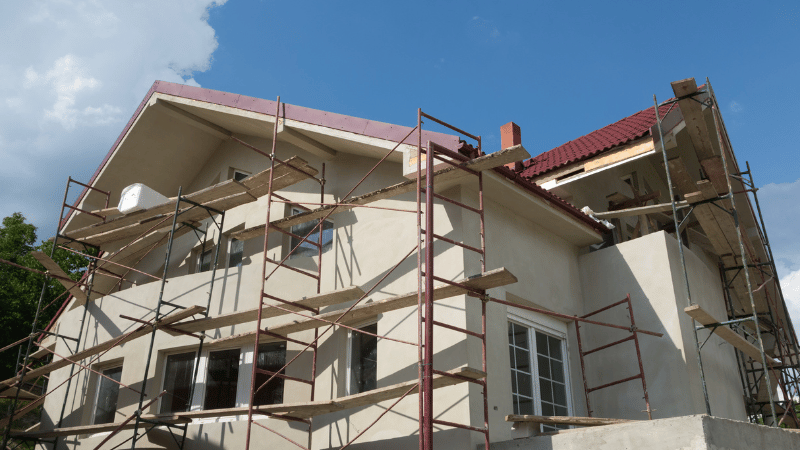Categories
A Guide To Bridging Loan Interest Rates

Bridging loan interest rates - how do they work and what can you do to keep costs down when using bridging finance to fund a property purchase?
Bridging loans can be an excellent way to finance property and are often best suited to circumstances that demand speed and flexibility.
Get started with our calculator
While many are familiar with how mortgage costs are structured, bridging loan repayments and interest rates are calculated differently. In order to find the best rates and a suitable lender for your circumstances, you'll need an in-depth understanding of the average cost of a bridging loan and how interest works for these loans.
Bridging loan interest rates are mainly set by lenders but are also determined by a few other factors that alter the final amount you pay.
Unlike traditional borrowing, there is flexibility on how you choose to repay the interest on your loan.
With all this in mind, here is a simplified guide on the important elements of bridging loan interest rates and what you need to know before you take out a loan.
Key Takeaways:
- Bridging loans are a fast, short-term financial solution that are option used for situations requiring flexibility and a quick turnaround.
- Rates are typically between 0.5% and 2% per month, varying based on factors like property type, loan-to-value (LTV) ratio, exit strategy, and lender.
- Unlike mortgages, bridging loans have interest rates quoted monthly, as they are designed for repayment within a short term, often within 12 months.
- Bridging loan rates tend to be higher than mortgage rates, but the total cost may be lower because they are short term.
Related: Bridging Loan: How Much Can I Borrow?
Skip to:
How Do Bridging Interest Rates Work?
How is Interest Repaid on a Bridge Loan?
Are Bridging Loan Interest Rates Higher Than Mortgage Rates?
How Long Do You Pay Bridging Loan Interest For?
Are There Other Costs With Bridge Loans?
How to Compare the Best Bridging Loan Interest Rates
Need Advice on Bridge Loan Interest Rates?
How Much Are Bridging Loan Interest Rates?
Bridging loan interest rates can range between 0.5% and 2% per month.
The exact rate you get will depend on:
- The type of property you're buying
- Your exit strategy (e.g., refinancing to a mortgage or selling an existing property)
- How quickly you need finance arranged
- Whether you're completing development works
- Your loan to value (LTV)
- The lender you use

Fergus Allen
Head of Bridging
Let us do all the hard work of finding the right bridging lender for your circumstances.
We secure bridging finance for applications of all types, and we negotiate competitive lending to meet your needs and timescale.
How Do Bridging Loan Interest Rates Work?
Fundamentally, bridging loan interest rates work in a similar manner to traditional borrowing, like you see with a standard mortgage:
The interest rate is set by the lender and is commonly paid in a lump sum at the end of the loan term.
The main difference between bridge loan interest and traditional mortgage interest is that your bridging loan rate will be quoted as monthly, while a standard mortgage is quoted as annually (APR).
Bridging loans are designed to be repaid in a short amount of time – typically over 12 months – and therefore the interest rates applied can be more expensive.
But most bridging lenders will only charge you interest on the months that your loan is outstanding, with no early repayment charges (ERCs).
For example, if you take out a 12-month bridging loan but repay it after 3 months, you'll only pay 3 months of interest.
Bear this in mind when looking at bridging loan quotes because they can be a lot cheaper when you factor this in.
Some lenders will even calculate your interest on a daily basis – so, if you repay your loan halfway through a month, you’ll only pay for the days in the month that you’ve had your loan outstanding.
See the latest market news below.
2025 Bridging Market Update
The bridging market has had quite a transformation in the past few years. With rates starting at 0.55% per month, the costs aren’t dissimilar from those of a mortgage, and the combination of flexibility, quick turnaround time and less stringent eligibility criteria has led to bridging finance growing in popularity.
It’s now seen as a product in its own right instead of an expensive alternative to long-term finance.
Our finance brokers are seeing more repeat clients, particularly investors who have turned their attention to property flipping considering the slim profit margins the buy to let market has been seeing. HMO conversions have also grown in popularity amid more rigid rental legislation.
According to our team of advisers, a high volume of first-time borrowers already have an understanding of bridging loans before approaching us, showing that bridging is becoming more recognised in the industry.
As bridging finance becomes more mainstream, lenders are reviewing and reducing rates more frequently, offering more flexibility around costs.
Watch our short video below on using a bridging loan to buy a house before you've sold yours.
How are Bridging Loan Interest Rates Calculated?
Bridging loan interest rates are quoted on a monthly basis, not annually, like your mortgage is.
The calculations are generally based on:
- The total amount you’re borrowing
- Your LTV (Loan-to-Value)
- How much deposit/security you can put down
- The length of your loan terms
As well as several other factors based on a risk assessment set out by your lender. The rates you’ll be quoted for a simple 'buying before selling bridging loan' might be cheaper than for a complex development bridging loan, for example.
Top tip: If you own an additional property you can put down as security for your bridging loan, you could get a reduced interest rate. But this discount generally maxes out at around 60% LTV.
How is Interest Repaid on a Bridging Loan?
How you repay the interest on your bridging loan will depend on the terms and conditions arranged with your lender.
With bridging loans, borrowers have a couple of options that differ from traditional mortgages, which can typically only be repaid monthly.
Generally, there are three common methods of repaying interest on a bridging loan:
- Rolled-up interest – With rolled-up interest, borrowers defer payment of interest until the end of the loan term. The interest owed is added to the principal amount, and at the end of the loan term, the borrower repays the total amount, with interest, in a lump sum. This is great for freeing up cash flow for moving costs or your development/refurbishment project.
- Monthly interest payments – This option is the same as your standard mortgage, with the borrower making payments monthly at a set amount. You'll repay the interest on your loan each month (without reducing the capital borrowed, as this is repaid at the end as a lump sum).
- Retained interest – Retained interest is a flexible option to rolled-up interest: your maximum interest payable is included in your original loan value. At the end of your term, you repay your loan in full and get a refund for any interest you didn’t use. The benefit? There are no extra payments to worry about at the end of your loan.
Bridging loans are short-term finance, so you won't face any early repayment charges if you pay your bridging loan before your term ends. If you have the means to do so, you can repay interest and your total loan amount before the end of your loan term with no hassle.
Are Bridging Loan Interest Rates Higher Than Mortgage Rates?
Yes, for the most part, interest rates on bridging loans are higher than mortgage rates. This is mainly because bridging loans span a much shorter period than mortgages.
But while you’ll pay more for a bridging loan during the short time you’ll be using it, the overall costs will be lower compared to the total lifetime of a standard mortgage (20-30 years).
That said, interest rates and fees associated with a bridge loan can vary significantly depending on the lender and the borrower's financial circumstances.
Those looking to secure a bridge loan should always take care when comparing interest rates offered by various lenders and look at the terms of a loan carefully. It’s also important to consider the overall cost of your bridging loan and not just the interest rate.
Here's a snapshot of bridging loan interest rates we've recently secured for clients:
Residential
Buying Before Selling?
Rates from:
0.55% pm
Downsizing/Upsizing
Releasing Funds From Your Home
Short-Term Lease Finance
Auction Purchase
As at 17th January 2025
Development & Refurb
Fast Finance
Rates from:
0.55% pm
Light & Heavy Refurb
Finance For Unmortgageable Properties
Land Purchase with planning
As at 17th January 2025
Residential
Large Bridging Loans
Rates from:
0.55% pm
Up to 80% LTV
Minimum Loan £500k
Minimum net income £100k
As at 17th January 2025
Contact Us
Thank You for your interest - please complete the form below and a member of our team will be in contact.
How Long Do You Pay Bridging Loan Interest For?
You usually have the option to only pay interest on your bridging loan for the months in which your loan is taken out.
As previously discussed, if you repay it early, you can avoid paying interest on months you didn’t use.
Drawdown options:
Some bridging lenders also offer drawdown options, meaning a bridge loan can be drawn down in stages over the course of the term.
You’ll only pay interest on the amount you’ve drawn down at each stage, which can be incredibly valuable for property renovations or development projects.
For example, if you need a development bridging loan of £1m for your project, you won’t be able to spend and utilise that full £1m from day one – you’re going to spend it in stages throughout the completion of your project.
So, a drawdown facility means you can take your agreed loan in stages – perhaps £300k upfront, £200k 3 months later, and the final £500k as and when you need it.
A good bridging loan broker will be able to negotiate the flexibility you need for your project.
Are Interest Rates Fixed or Variable?
Typically, bridge loan interest rates are fixed and set by the lenders and determined by the factors previously mentioned.
They are also affected by interest rate fluctuations in the market in line with the Bank of England’s base rate – however, they arguably follow these less closely than standard mortgage rates due to the bespoke nature of bridging finance.
A fixed interest rate means that the interest being paid will remain the same throughout the entire period of the loan and is not subject to the shifts in interest rates in the UK.
Fixed interest rates offer a certain amount of stability and predictability when it comes to knowing exactly what amount you will be paying monthly or paying at the end of your term in a rolled-up sum.
For more information on bridging loan interest rates, other costs and example uses, our video below sums it all up:
Related: Get the latest on UK interest rates in our news piece 'Are interest rates going down?'
What Are Some of The Other Costs Involved in Bridging Finance?
In addition to interest payments, there are a number of other costs associated with bridge finance that it’s important to be aware of.
The bridging loan with the cheapest interest rate isn’t necessarily the cheapest overall.
This is where the expertise of a good broker comes in.
You also need to factor in:
- Arrangement fees – charged by lenders for facilitating the bridge, which are typically a fixed fee
- Valuation fees – all property used as security for a loan must be evaluated by the lender to determine its worth and suitability
- Legal fees
- And other admin fees
For a comprehensive guide to bridging loan costs and what to look out for, read our separate guide to bridging loan fees.
Get started with our calculator
How Can You Find and Compare the Best Bridging Loan Interest Rates?
Preparation and an understanding of your own circumstances and requirements are essential when looking to find the best available rates from the many lenders out there.
When it comes to bridging finance, there are an overwhelming number of options to choose from and to investigate.
They’re not all listed on the few ‘comparison sites’ that operate in the market, and when you factor in the complexities of each case, the quotes can often vary greatly between lenders.
This is why it is beneficial to utilise bridging loan brokers – experts in the field armed with the knowledge to find borrowers the right lender for the job.
It’s often best to seek professional advice when it comes to bridge finance, but you can also read more here on how to find and compare the best bridging loans.
Need Advice on Bridging Loan Interest Rates?
Here at Clifton Private Finance, we can help guide you through your available options whether you're new to bridging loans or are more experienced with using this type of financing.
Due to the overall cost of a bridge loan, when making any important financial decision it’s good to seek the help of a bridging loan expert to ensure you’re getting finance at an affordable and favourable rate.
Call us today on 0117 959 5094 to see how we can help, or book a consultation with us below.


FAQs
What Factors Affect Bridging Loan Interest Rates?
The loan term, property type, loan amount, LTV, and creditworthiness of the borrower are all factors that can impact an individual bridge loan’s interest rate – but this isn’t an exhaustive list.
What Happens if I Can’t Make Interest Payments on a Bridging Loan?
If you cannot repay your loan within the terms, your lender may apply certain penalties, such as: late payment fees, default interest rates, or legal repercussions.
If you can’t afford to repay the capital of your loan, your lender could repossess the property to recover your debt. This is why it’s important to have a solid exit plan – speak to a bridging adviser if you’re unsure on your plan.
There could also be an impact on your credit score.
Can I Get a Bridging Loan with a Low Interest Rate?
Interest rates differ from lender to lender and your circumstances. Some may be lower than others, but typically, interest rates will be higher than that of traditional borrowing due to the repayment period being much shorter.
The better you meet the bridging loan criteria of your specific lender, the lower your interest rate is likely to be.
Seeking advice from a whole of market broker like Clifton Private Finance and shopping around for the best options can result in finding a favourable deal.









